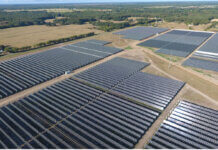Earlier this year, Wells Fargo announced leadership changes for its renewable energy and environmental finance business. Phil Hopkins, who co-led the group with Barry Neal for more than a decade, took over as the sole leader following Neal’s retirement on July 1.
Before he joined Wells Fargo in 2005, Hopkins was director of strategy and business analysis at Mirant Corp. (now GenOn Energy Holdings), senior engineer at the New England Power Co. and field engineer for Schlumberger Well Services. He received a master’s degree in nuclear engineering and bachelor’s degree in mechanical engineering from the Massachusetts Institute of Technology, where he was also a Nuclear Regulatory Commission-licensed senior reactor operator at the Nuclear Reactor Laboratory.
Solar Industry recently interviewed the energy industry veteran to learn more about Wells Fargo’s expanding wind and solar investments over the years, as well as the renewable energy and environmental finance team’s plans going forward.
1. When did Wells Fargo first begin funding renewable energy projects, and what are some of the most notable investments?
Wells Fargo made its first tax equity commitment to a wind project in 2006 and, shortly thereafter, began investing in distributed generation solar. Since then, our portfolio has grown and matured with the industry, and over the past 13 years, we have financed progressively larger wind and solar projects for an expanding base of customers. Notable investments include several portfolio financings, where we invest in multiple large projects via a single transaction, and ownership stakes in some of the largest individual wind and solar projects in the nation. Since inception, we have provided over $7.5 billion of tax equity financing to our customers in support of more than 400 projects.
2. What are Wells Fargo’s renewable energy investment plans in the short and long term?
Wells Fargo’s renewable energy and environmental finance team provided approximately $1.5 billion in tax equity financing to U.S. renewable energy projects in 2018, including our first combined debt/tax equity financing. This year, we anticipate that we will exceed this number, close our first fuel cell transaction, and fund our first utility-scale solar and storage project. While further strengthening our market position in traditional wind and solar, we also continue to explore other sectors and technologies, like battery storage and carbon sequestration. Also, by collaborating closely with other Wells Fargo business lines, we are able to provide more comprehensive and strategic coverage to our customers.
3. With your experience with Mirant, New England Power Co., Schlumberger and MIT’s Nuclear Reactor Lab, what made you decide to enter the renewable energy business?
Like most things in life, it was a little bit of planning and a lot of good luck. When I joined Wells Fargo in 2005, the renewable energy tax credits had lapsed and the bank had not previously invested in the sector, so my focus was on more traditional forms of power generation. When the tax credits were extended later that year, however, we quickly recognized the market opportunity and began to build the strong customer relationships that resulted in our first projects. The planets then aligned, because Wells Fargo was consistently able to provide significant capital and tax capacity to our customers in this rapidly growing sector. Our early efforts also coincided with the bank’s first environmental commitment, which has now grown into the $200 billion program announced last year – and we haven’t looked back since.
4. Are your wind and solar investments focused on any particular U.S. regions?
Wells Fargo has investments in 30 U.S. states and territories – from Hawaii to Maine to Puerto Rico – with heavy solar concentration in the Southwest and Northeast and wind investments concentrated in the Central states.
5. Has the impending sunset of the production tax credit and investment tax credit affected U.S. investment decisions? And the solar tariffs?
Legislation enacted in 2015 not only established a gradual phase-out of the tax credits but also eliminated the prior “placed-in-service” deadlines in favor of “begun-construction” deadlines for tax credit qualification. This provided much needed clarity to our developer customers and allowed them to plan more effectively over longer horizons. For this reason, we are still financing wind projects that began construction in 2016 and are eligible to receive the full production tax credit, and we expect to see similar continuity in solar as the investment tax credit begins to step down in 2020. If anything, the credits’ phase-out has so far led to faster project development and a more consistent supply of financing opportunities. And while tariffs have put upward pressure on both modules and steel prices, these cost increases largely have been offset by falling costs in other aspects of development, construction and financing.
6. What hurdles do you feel are still facing the U.S. wind and solar markets?
Although federal tax credits are being phased out under the current legislation, wind and solar technologies are now well-proven, and delivered energy costs have declined to the point that renewables can compete in many markets without subsidies. As the tax credits expire, however, the industry will need to develop new and different financing structures to fund its growth and also meet the challenge of integrating so many intermittent resources into the grid. We expect energy storage, demand response programs and the other innovative technologies to be part of the solution, and we are currently exploring these opportunities with our customers.
7. What do you feel are some of the biggest milestones in the U.S. renewable energy industry over the past 13 years?
While the industry continues to reach quantitative milestones regarding installed capacity, energy production, project size and installed cost, some of the most important milestones to me are more qualitative: for instance, the increasing number of projects that sell energy directly to big corporations instead of utilities, the growing number of community choice aggregators that purchase renewable energy for their customers, and the accelerating demand for renewable energy investment opportunities among pension funds and other long-term investors. Combined with the statistics, these qualitative milestones indicate more widespread acceptance, adoption and focus on renewable energy.
8. As the sole leader of the renewable energy and environmental finance business going forward, what are your goals for the company?
At Wells Fargo, the customer is at the center of everything we do, and my goal is for the company to continue providing the full spectrum of financial products and services to our renewable energy customers as they change and grow. Our dedicated team is providing highly specialized project finance, corporate and investment banking, capital markets and advisory services in an integrated way to customers industry-wide and is committed to helping them succeed.




